阅读:0
听报道
作者:蒋宝尚、魏子敏
《复仇者联盟4》终于上映,这部汇集了10年回忆打造的电影,据看过的小伙伴们表示:3小时剧情,毫无尿点,全程都是经典回忆。
忙着工作还没来得及看电影,又超怕被剧透的文摘菌这两天的状态基本是这样。
万般捉急的文摘菌在这周也去重新回忆了一下这个系列的作品。这部电影是复仇者系列的终结作品,能有如此成就,离不开《钢铁侠》、《美国队长》,《雷神》、《绿巨人》等独立叙事电影为其构建的宏大的宇宙观,也在全球观众心里种下同一种英雄情结。
复仇者系列火遍全球绝非意外,这部作品尽管出现了各种人物,但是每个英雄又都被塑造地各具特色,让人一次就能记住。
而台词可以说是最能塑造人物性格的部分了。因此,文摘菌希望用数据分析的方式,看看漫威宇宙的英雄最爱用的词汇可视化,并通过此分析他们的人物特点,向这部伟大的作品致敬。
本次分析,我们主要使用了R语言进行编程,目的是找出最能代表每位英雄的词汇。数据选用了三个比较有代表性的漫威英雄交叉度极高的剧本,分别是:《复仇者联盟》(就是打洛基的那一部)、《复仇者联盟:奥创纪元》以及《美国队长:内战》。
上代码前,先来看看分析结果。
1、美国队长:以你的名字呼唤你-钢铁侠!
作为联盟的老大哥,美国队长超爱喊别人的名字。并且我们发现,他口中最经常出现的名字是就是钢铁侠。此外,还经常点名的是Sam,和Strucker。
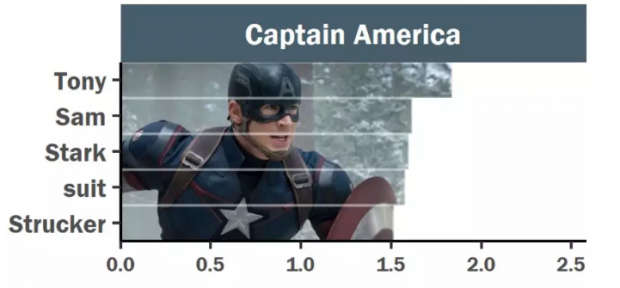
美国队长和钢铁侠可谓《复仇者联盟》系列中两大相爱相杀的主角了。两人在电影中都是领导级别的角色,但是两者的追求却有很大的差异。在电影《美国队长:内战》中,复仇者联盟团队彻底分崩离析,分别从属了美国队长和钢铁侠两大阵营。
一方面美国队长为了自己的好朋友冬兵战斗,另一方钢铁侠为了维护世界的秩序和为自己的父母报仇战斗。两者即是好友,又是同级别的对手,这或许也就解释了为什么美国队长总是叫钢铁侠的名字。
2.黑豹:最喜欢谈论“中二“话题的贵族
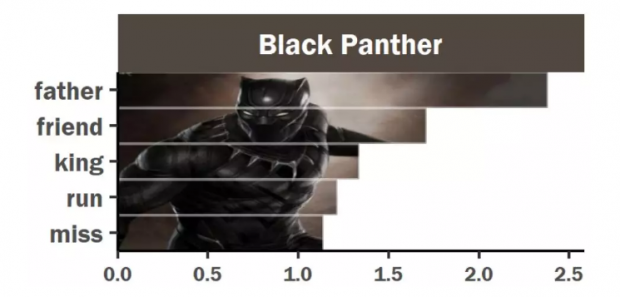
从分析结果来看,黑豹最喜欢说的是父亲、朋友,国王等听起来比较“中二“的词语。
黑豹的父亲前任黑豹特查卡,瓦坎达的国王!守护者振金,是黑豹的偶像,却在电影中死于一场阴谋。而黑豹作为瓦坎达的领袖,年轻的王位继承人,将他父亲的遗志作为了追求的梦想,守护着瓦坎达。国王身份,追求理想,这就是黑豹喜欢谈论这类贵族话题的原因。
3.蜘蛛侠:我还是个“宝宝“。
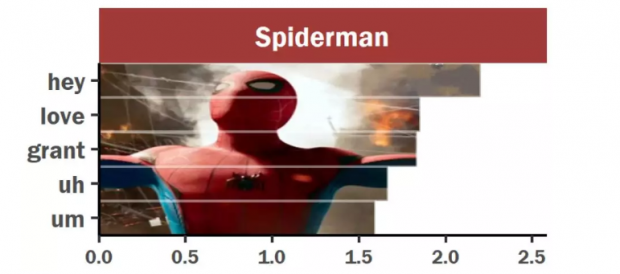
作为全队的“小朋友“,蜘蛛侠在复仇者联盟系列电影中的台词一直比较幼齿,他在电影中说的最多的是词是:“嗨”、“呃”、“嗯”。
在这三部电影中,蜘蛛侠只是一个十几岁的孩子,在这么多大人物面前如果再不蹦蹦跳跳,那就更没有存在感了☺。
4.浩克和鹰眼:大家都爱黑寡妇。

通过可视化分析可以发现,绿巨人和鹰眼都非常喜欢提到黑寡妇。
浩克喜欢和黑寡妇聊天原因很简单,因为当绿巨人发狂时,黑寡妇用满心关爱的眼神瞅着他那庞大的身躯,对他说道:“嘿,大块头,太阳快下山了!”然后慢慢地举起了手,用她那柔软的手指,伸向了绿巨人的手臂,轻轻滑了下来。这时候浩克就会平息他那满腔的怒火!
电影中黑寡妇和鹰眼不是恋人或者情侣,他们的关系一直恋人未满、暧昧不清。但是,因为两人在复仇者联盟之前就已经发生了一系列故事。刀光剑影,爱恨情仇,即是老友又是战友,或许两人早已暗生情愫。
5.幻世和绯红女巫:惺惺相惜,在线发糖!
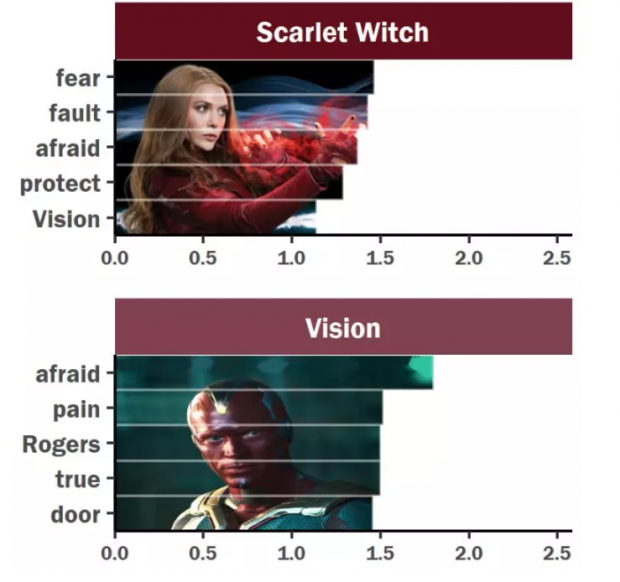
从数据可视化的结果中可以看到,幻视和绯红女巫绝对是soulmate了,两人的谈论内容都很一致,特别喜欢说“恐惧、担忧“类话题!
关于绯红女巫,我们可以从她童年的经历和非人的待遇中找到原因。而幻世作为超级人工智能,能够看到别的英雄看不到的“画面”,可能对未来的担忧让他心烦意乱。
6.托尔:能力越大,责任越大,考虑深远
托尔作为雷神,拥有多种魔法能力,例如:操控风暴,释放或控制闪电,将闪电能量实体化为盔甲,瞬间改变天气,利用雷神之锤飞行,召唤雷神之锤令其飞回托尔用闪电与敌人交战。
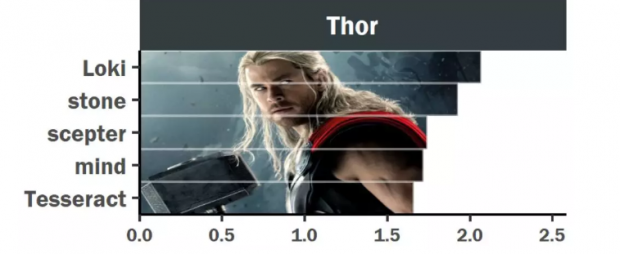
雷神除去强大的战斗力,托尔还掌握着星际级的知识。例如:无限宝石知识、各式星际飞船驾驶技术、格鲁特语(格鲁特所在种族的语言)、虫洞知识。
或许是能力越大,责任越大,他比其他英雄角色看的更远。在电影中,他对推动剧情前进的物品更加专注,例如洛基的权杖以及心灵宝石。
7.洛基:追逐权力。

洛基从小和雷神托尔一起长大。一直窥视众神之王的宝座且不认同雷神托尔会是一位合格的继承人。他野心十足想当老大,阴险狡诈陷害兄长、反逆父母,视天下生命如草芥,为了目的不择手段。
总之一句话,他非常想要权力!
8.奥创:更爱“诗和远方“。
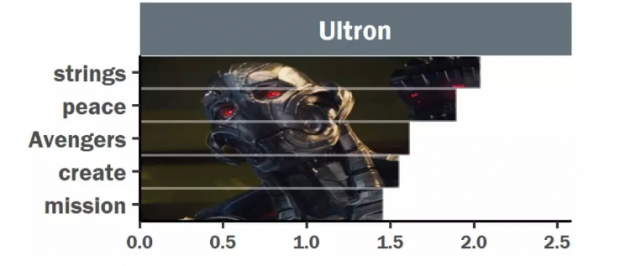
奥创被制造出来的目的是为了守护和平,但是一诞生就发生错误,认为想要和平就要消灭人类和复仇者联盟,于是抢走洛基权杖(心灵宝石)从尤利西斯·克劳手中弄到大量的振金,操纵赵海伦利用再生摇篮帮其制造幻视身体,想要进化得更强。
换句话说,奥创一出生就被订上了守护和平的烙印,虽然他看问题的角度不同,但是和复仇者联盟有着共同的任务。所以,它更加向往诗与远方!
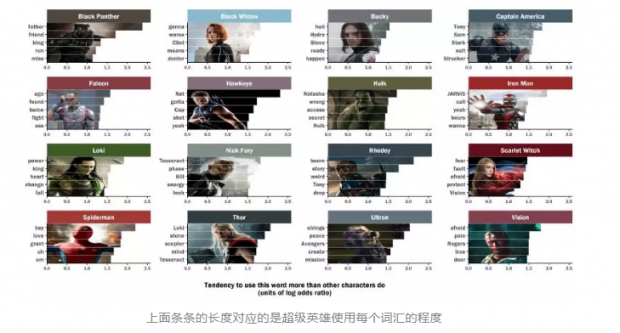
可视化过程
最后,分析完全剧的角色,我们也来一起看看整个可视化过程。
导入R语言包
library(dplyr)
library(grid)
library(gridExtra)
library(ggplot2)
library(reshape2)
library(cowplot)
library(jpeg)
library(extrafont)
清除R工作环境中的全部东西
rm(list = ls())
加载包含所有图片的文件夹(根据你自己的情况修改代码)
dir_images <- "C:\\Users\\Matt\\Documents\\R\\Avengers"
setwd(dir_images)
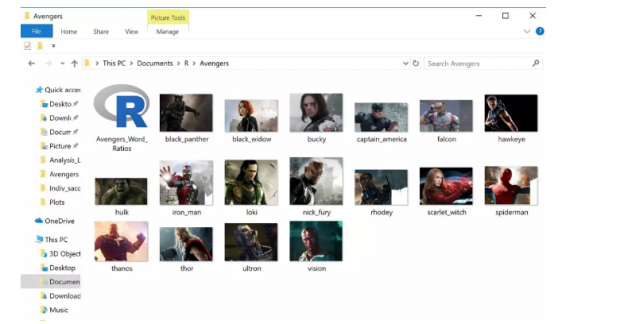
设置字体
windowsFonts(Franklin=windowsFont("Franklin Gothic Demi"))
英雄角色名字的简化版本
character_names <- c("black_panther","black_widow","bucky","captain_america",
"falcon","hawkeye","hulk","iron_man",
"loki","nick_fury","rhodey","scarlet_witch",
"spiderman","thor","ultron","vision")
image_filenames <- paste0(character_names, ".jpg")
将所有图片读入一个列表中。
all_images <- lapply(image_filenames, read_image)
将角色名字分配给图像列表,以便按名字对其进行索引。
names(all_images) <- character_names
例如
# clear the plot window
grid.newpage()
# draw to the plot window
grid.draw(rasterGrob(all_images[['vision']]))
获得文本数据
数据由计算机科学家Elle O'Brien收集的,使用文本挖掘技术对电影剧本分析。
更正专有名称的大写
capitalize <- Vectorize(function(string){
substr(string,1,1) <- toupper(substr(string,1,1))
return(string)
})
proper_noun_list <- c("clint","hydra","steve","tony",
"sam","stark","strucker","nat","natasha",
"hulk","tesseract", "vision",
"loki","avengers","rogers", "cap", "hill")
# Run the capitalization function
word_data <- word_data %>%
mutate(word = ifelse(word %in% proper_noun_list, capitalize(word), word)) %>%
mutate(word = ifelse(word == "jarvis", "JARVIS", word))
请注意,以前的简版角色名字与文本dataframe格式中的角色不匹配。
unique(word_data$Speaker)
## [1] "Black Panther" "Black Widow" "Bucky"
## [4] "Captain America" "Falcon" "Hawkeye"
## [7] "Hulk" "Iron Man" "Loki"
## [10] "Nick Fury" "Rhodey" "Scarlet Witch"
## [13] "Spiderman" "Thor" "Ultron"
## [16] "Vision"
创建一个索引表,将文件名转换为角色名。
character_labeler <- c(`black_panther` = "Black Panther",
`black_widow` = "Black Widow",
`bucky` = "Bucky",
`captain_america` = "Captain America",
`falcon` = "Falcon", `hawkeye` = "Hawkeye",
`hulk` = "Hulk", `iron_man` = "Iron Man",
`loki` = "Loki", `nick_fury` = "Nick Fury",
`rhodey` = "Rhodey",`scarlet_witch` ="Scarlet Witch",
`spiderman`="Spiderman", `thor`="Thor",
`ultron` ="Ultron", `vision` ="Vision")
有两个不同版本的角色名,一个用于显示(漂亮),一个用于索引(简单)
convert_pretty_to_simple <- Vectorize(function(pretty_name){
# pretty_name = "Vision"
simple_name <- names(character_labeler)[character_labeler==pretty_name]
# simple_name <- as.vector(simple_name)
return(simple_name)
})
# convert_pretty_to_simple(c("Vision","Thor"))
# just for fun, the inverse of that function
convert_simple_to_pretty <- function(simple_name){
# simple_name = "vision"
pretty_name <- character_labeler[simple_name] %>% as.vector()
return(pretty_name)
}
# example
convert_simple_to_pretty(c("vision","black_panther"))
## [1] "Vision" "Black Panther"
将简化的角色名称添加到文本数据框架中。
word_data$character <- convert_pretty_to_simple(word_data$Speaker)
为每个角色指定主颜色
character_palette <- c(`black_panther` = "#51473E",
`black_widow` = "#89B9CD",
`bucky` = "#6F7279",
`captain_america` = "#475D6A",
`falcon` = "#863C43", `hawkeye` = "#84707F",
`hulk` = "#5F5F3F", `iron_man` = "#9C2728",
`loki` = "#3D5C25", `nick_fury` = "#838E86",
`rhodey` = "#38454E",`scarlet_witch` ="#620E1B",
`spiderman`="#A23A37", `thor`="#323D41",
`ultron` ="#64727D", `vision` ="#81414F" )
绘制条形图
avengers_bar_plot <- word_data %>%
group_by(Speaker) %>%
top_n(5, amount) %>%
ungroup() %>%
mutate(word = reorder(word, amount)) %>%
ggplot(aes(x = word, y = amount, fill = character))+
geom_bar(stat = "identity", show.legend = FALSE)+
scale_fill_manual(values = character_palette)+
scale_y_continuous(name ="Log Odds of Word",
breaks = c(0,1,2)) +
theme(text = element_text(family = "Franklin"),
# axis.title.x = element_text(size = rel(1.5)),
panel.grid = element_line(colour = NULL),
panel.grid.major.y = element_blank(),
panel.grid.minor = element_blank(),
panel.background = element_rect(fill = "white",
colour = "white"))+
# theme(strip.text.x = element_text(size = rel(1.5)))+
xlab("")+
coord_flip()+
facet_wrap(~Speaker, scales = "free_y")
avengers_bar_plot
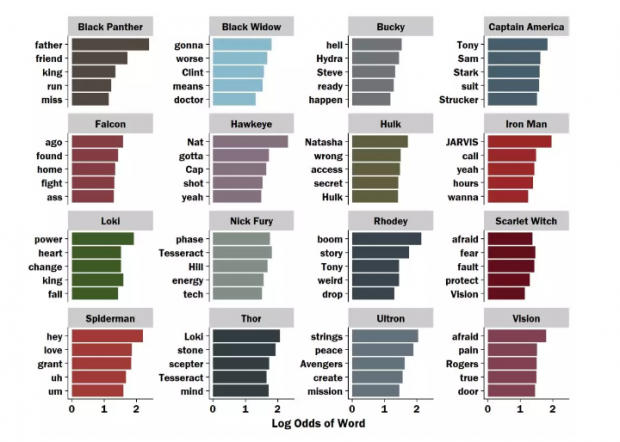
这已经非常漂亮了,但是还可以更漂亮。比如人物形象通过“线条”显示出来。具体做法是将透明的条形图全覆盖,然后从端点向里绘制白色的条形图,注意条形图是能够遮挡图片的。

在数据框架中,用达到总最大值所需的余数来补充数值,这样当将值和余数组合在一起时,就会形成长度一致的线条组合。
max_amount <- max(word_data$amount)
word_data$remainder <- (max_amount - word_data$amount) + 0.2
每个英雄角色仅提取5个关键词。
word_data_top5 <- word_data %>%
group_by(character) %>%
arrange(desc(amount)) %>%
slice(1:5) %>%
ungroup()
将“amount”和“remaining”的格式进行转换
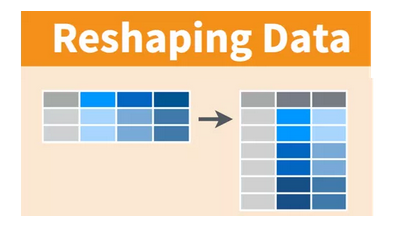
确保每个角色有两个长条;一个用于显示amount,另一个用于选择结束位置。
这会将“amount”和“remaining”折叠成一个名为“variable”的列,指示它是哪个值,另一列“value”包含每个值中的数字。
word_data_top5_m <- melt(word_data_top5, measure.vars = c("amount","remainder"))
将这些条形图放在有序因素中,与在数据融合中相反。否则,“amount”和“remainder”将在图上以相反的顺序显示。
word_data_top5_m$variable2 <- factor(word_data_top5_m$variable,
levels = rev(levels(word_data_top5_m$variable)))
每个角色仅仅显示五个词汇
注意角色名称的版本问题,例如采用“black_panther”而不是“Black Panther”
plot_char <- function(character_name){
# example: character_name = "black_panther"
# plot details that we might want to fiddle with
# thickness of lines between bars
bar_outline_size <- 0.5
# transparency of lines between bars
bar_outline_alpha <- 0.25
#
# The function takes the simple character name,
# but here, we convert it to the pretty name,
# because we'll want to use that on the plot.
pretty_character_name <- convert_simple_to_pretty(character_name)
# Get the image for this character,
# from the list of all images.
temp_image <- all_images[character_name]
# Make a data frame for only this character
temp_data <- word_data_top5_m %>%
dplyr::filter(character == character_name) %>%
mutate(character = character_name)
# order the words by frequency
# First, make an ordered vector of the most common words
# for this character
ordered_words <- temp_data %>%
mutate(word = as.character(word)) %>%
dplyr::filter(variable == "amount") %>%
arrange(value) %>%
`[[`(., "word")
# order the words in a factor,
# so that they plot in this order,
# rather than alphabetical order
temp_data$word = factor(temp_data$word, levels = ordered_words)
# Get the max value,
# so that the image scales out to the end of the longest bar
max_value <- max(temp_data$value)
fill_colors <- c(`remainder` = "white", `value` = "white")
# Make a grid object out of the character's image
character_image <- rasterGrob(all_images[[character_name]],
width = unit(1,"npc"),
height = unit(1,"npc"))
# make the plot for this character
output_plot <- ggplot(temp_data)+
aes(x = word, y = value, fill = variable2)+
# add image
# draw it completely bottom to top (x),
# and completely from left to the the maximum log-odds value (y)
# note that x and y are flipped here,
# in prep for the coord_flip()
annotation_custom(character_image,
xmin = -Inf, xmax = Inf, ymin = 0, ymax = max_value) +
geom_bar(stat = "identity", color = alpha("white", bar_outline_alpha),
size = bar_outline_size, width = 1)+
scale_fill_manual(values = fill_colors)+
theme_classic()+
coord_flip(expand = FALSE)+
# use a facet strip,
# to serve as a title, but with color
facet_grid(. ~ character, labeller = labeller(character = character_labeler))+
# figure out color swatch for the facet strip fill
# using character name to index the color palette
# color= NA means there's no outline color.
theme(strip.background = element_rect(fill = character_palette[character_name],
color = NA))+
# other theme elements
theme(strip.text.x = element_text(size = rel(1.15), color = "white"),
text = element_text(family = "Franklin"),
legend.position = "none",
panel.grid = element_blank(),
axis.text.x = element_text(size = rel(0.8)))+
# omit the axis title for the individual plot,
# because we'll have one for the entire ensemble
theme(axis.title = element_blank())
return(output_plot)
}
单个角色是如何设置?
sample_plot <- plot_char("black_panther")+
theme(axis.title = element_text())+
# x lab is still declared as y lab
# because of coord_flip()
ylab(plot_x_axis_text)
sample_plot
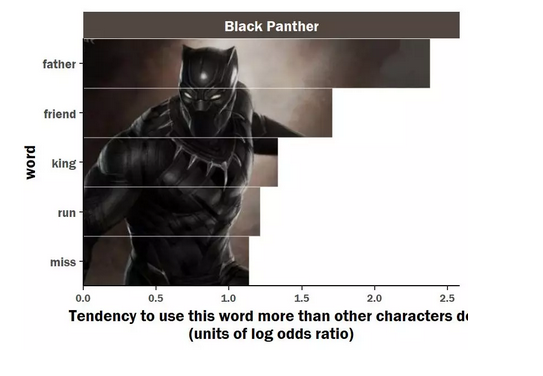
横轴为什么这么特殊?因为随着数值的增加,条形图会变得越来越高,因此需要转换刻度。
如下所示
logit2prob <- function(logit){
odds <- exp(logit)
prob <- odds / (1 + odds)
return(prob)
}
…这就是这个轴的样子:
logit2prob(seq(0, 2.5, 0.5))
## [1] 0.5000000 0.6224593 0.7310586 0.8175745 0.8807971 0.9241418
注意该列表中连续项之间的递减差异:
diff(logit2prob(seq(0, 2.5, 0.5)))
## [1] 0.12245933 0.10859925 0.08651590 0.06322260 0.04334474
好了,可以进行下一项了:探讨一些细节,并把上面设置的函数应用到所有角色的列表中,并把所有的结果放入一个列表中。
all_plots <- lapply(character_names, plot_char)
从图片中提取标题
get_axis_grob <- function(plot_to_pick, which_axis){
# plot_to_pick <- sample_plot
tmp <- ggplot_gtable(ggplot_build(plot_to_pick))
# tmp$grobs
# find the grob that looks like
# it would be the x axis
axis_x_index <- which(sapply(tmp$grobs, function(x){
# for all the grobs,
# return the index of the one
# where you can find the text
# "axis.title.x" or "axis.title.y"
# based on input argument `which_axis`
grepl(paste0("axis.title.",which_axis), x)}
))
axis_grob <- tmp$grobs[[axis_x_index]]
return(axis_grob)
}
提取轴标题
px_axis_x <- get_axis_grob(sample_plot, "x")
px_axis_y <- get_axis_grob(sample_plot, "y")
下面是如何使用提取出来的坐标轴:
grid.newpage()
grid.draw(px_axis_x)
# grid.draw(px_axis_y)
汇总所有的英雄
big_plot <- arrangeGrob(grobs = all_plots)
加入图注,注意图和坐标轴的比例关系
big_plot_w_x_axis_title <- arrangeGrob(big_plot,
px_axis_x,
heights = c(10,1))
grid.newpage()
grid.draw(big_plot_w_x_axis_title)
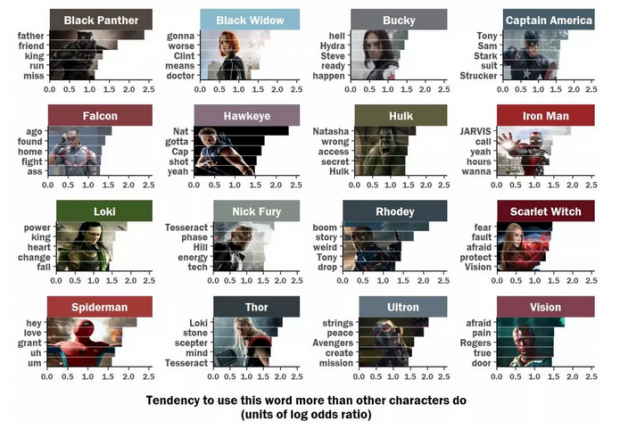
因为词汇的长度不同,这些图表占用的页面空间略有不同。
所以,这看起来有点乱。
一般来说,我们使用facet_grid()或facet_wrap()确保在绘图的过程中保持整齐和对齐,这个项目中不再适用,因为每个都有自己的自定义背景图像。
使用Cowplot而不是arrangebrob,让图片的轴垂直对齐
big_plot_aligned <- cowplot::plot_grid(plotlist = all_plots, align = 'v', nrow = 4)
增加X轴的标题,和之前类似,注意网格对齐
big_plot_w_x_axis_title_aligned <- arrangeGrob(big_plot_aligned,
px_axis_x,
heights = c(10,1))
然后,大功告成
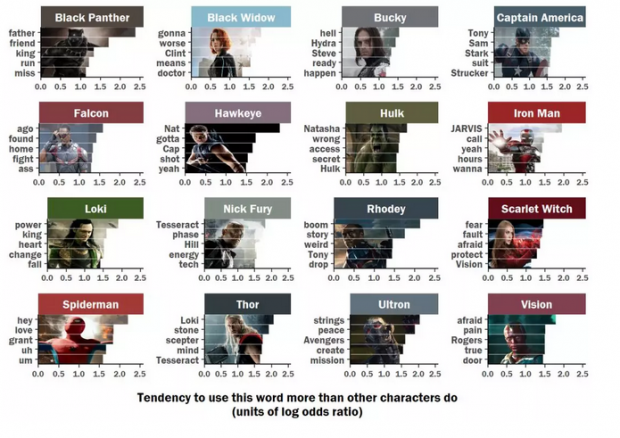
然后,保存一下!
ggsave(big_plot_w_x_axis_title_aligned,
file = "Avengers_Word_Usage.png",
width = 12, height = 6.3)
相关报道:
话题:
0
推荐
财新博客版权声明:财新博客所发布文章及图片之版权属博主本人及/或相关权利人所有,未经博主及/或相关权利人单独授权,任何网站、平面媒体不得予以转载。财新网对相关媒体的网站信息内容转载授权并不包括财新博客的文章及图片。博客文章均为作者个人观点,不代表财新网的立场和观点。




 京公网安备 11010502034662号
京公网安备 11010502034662号 